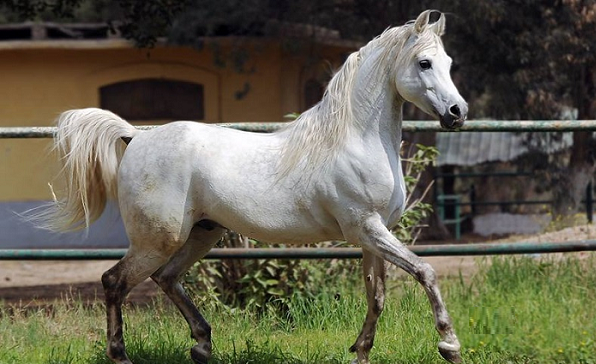Arabian horses aren’t just beautiful—they’re living legends. With a history that traces back thousands of years to the deserts of the Middle East, these horses have become symbols of grace, power, and loyalty. But not all Arabians are the same. In fact, there are several types of Arabian horses, each with its own look, history, and temperament. In this guide, we’ll explore the different types of Arabian horses, their breed names, and famous Middle Eastern bloodlines, while diving deep into the Polish Arabian vs Egyptian Arabian comparison.
History and Origins of Arabian Horses

Ancient Desert Roots
Arabian horses are among the oldest horse breeds in the world. Originally developed by Bedouin tribes in the harsh deserts of the Arabian Peninsula, they were bred for stamina, loyalty, and intelligence—traits that made them ideal warhorses and companions.
Nomadic Breeding Practices
Bedouins kept meticulous oral records of their horses’ bloodlines, often treating prized mares as part of the family. This selective breeding over centuries ensured a pure and consistent gene pool.
Arabian Horse Influence on Global Horse Breeds
From the Thoroughbred to the Quarter Horse, many modern breeds owe their refinement, endurance, and spirit to Arabian blood. Arabian horses have been exported and integrated into breeding programs across Europe, Russia, and the Americas.
Physical Characteristics of Arabian Horses

Distinctive Facial Profile
Arabians are known for their “dished” face—a concave profile that gives them an expressive, alert look.
High Tail Carriage
Thanks to their unique skeletal structure, Arabians carry their tails high, a trait that sets them apart in any ring or pasture.
Compact Body Structure
Arabians have a short back, a well-arched neck, and dense bone structure, contributing to their strength and balance despite their relatively small size.
Core Arabian Horse Bloodlines

Overview of Middle Eastern Bloodlines
Arabian bloodlines are typically divided by region or origin, such as Egyptian, Polish, Russian, Spanish, and Crabbet. Each line reflects the breeding goals and cultural values of its origin.
The Five Al Khamsa Strains
According to legend, the Prophet Muhammad chose five mares based on their courage and loyalty. These became the foundational strains: Kuhaylan, Saqlawi, Hamdani, Hadban, and Abeyan. Al Khamsa horses are considered purebred descendants of desert Arabians.
The Different Types of Arabian Horses

Egyptian Arabian
Traits and Characteristics
Egyptian Arabians are often regarded as the purest of all Arabians. They have refined features, deep expressive eyes, a graceful neck, and extreme type.
Breeding Legacy
Egypt has preserved Arabian horses for centuries, with state studs like El Zahraa leading the charge. Their bloodlines are cherished worldwide.
Polish Arabian
Traits and Characteristics
Polish Arabians are known for a blend of beauty and athleticism. They have stronger bone structure, longer backs, and are slightly taller than Egyptian types.
Post-War Revival and Polish State Studs
After WWII, Poland rebuilt its Arabian stock through state studs like Janów Podlaski and Michałów, becoming global leaders in Arabian breeding.
Russian Arabian
Athletic Build and Racing Focus
Bred for performance, Russian Arabians have a robust body, excellent bone density, and are frequently used in racing and endurance disciplines.
Spanish Arabian
Conformation and Refinement
Spanish Arabians are highly valued for their excellent conformation, upright carriage, and noble heads. They tend to be more elegant and refined.
Crabbet Arabian
English Influence and Endurance Qualities
Originating from England’s Crabbet Park Stud, these Arabians are renowned for soundness and stamina, making them stars in endurance racing and sport horse crosses.
Egyptian Arabian vs. Polish Arabian

Differences in Conformation
- Egyptian Arabians: Smaller, more refined, classic dish face, extreme Arabian type
- Polish Arabians: More muscular, often taller, broader chests, slightly less “typey” but powerful
Differences in Temperament
- Egyptian: Sensitive, intelligent, and often high-spirited
- Polish: Calm, trainable, athletic—great for sports and shows
Bloodline Purity and Reputation
Egyptian lines are seen as more “pure” by purists, while Polish lines are admired for producing champions in both show and sport.
How Bloodlines Affect Performance and Use

Racing
Russian and Polish Arabians dominate Arabian flat racing due to their strength and stamina.
Endurance Riding
Crabbet and Polish lines excel here thanks to their bone structure and metabolic efficiency.
Show Competitions
Egyptian and Spanish Arabians are favored in halter and beauty-based shows due to their extreme refinement.
Choosing the Right Type of Arabian

For Breeding
Egyptian Arabians are ideal if you’re aiming for purity and elegance. Polish lines bring athleticism and versatility.
For Sports and Endurance
Crabbet, Russian, and Polish Arabians are best suited here, offering both beauty and brawn.
For Show and Pleasure Riding
Spanish and Egyptian lines offer grace, beauty, and that signature Arabian charisma that shines in show rings.
Arabian Horse Registries and Preservation Efforts
Al Khamsa, WAHO, and Others
Organizations like WAHO (World Arabian Horse Organization) and Al Khamsa work to preserve Arabian horse bloodlines and educate breeders.
Role of Breed Purity and Documentation
Proper documentation ensures the preservation of each type’s lineage, health, and authenticity, particularly for rare lines like straight Egyptian Arabians.
Common Myths About Arabian Horse Types
“All Arabians Are the Same”
Wrong. From the elegant Egyptian to the powerhouse Polish, each type is unique in structure, performance, and personality.
“Egyptians Are Only for Showing”
Egyptians may excel in beauty, but they’re also intelligent and versatile. Many have proven themselves in dressage, endurance, and more.
Conclusion
Arabian horses are not just a single breed—they’re a legacy of rich bloodlines, unique traits, and distinct purposes. Whether you admire the majestic Egyptian Arabian or lean toward the powerful Polish type, there’s a perfect Arabian out there for every kind of rider or breeder. The key is understanding the history, characteristics, and capabilities of each type—and choosing the one that best fits your needs and heart.
FAQs
1. What is the rarest type of Arabian horse?
Straight Egyptian Arabians are among the rarest due to their strict breeding criteria and limited bloodlines.
2. Are Polish Arabians better than Egyptian Arabians?
Not better—just different. Polish Arabians are often stronger and more athletic, while Egyptians are known for their extreme beauty and type.
3. Which type of Arabian horse is best for endurance?
Crabbet and Polish Arabians tend to dominate endurance riding due to their bone density and stamina.
4. How can I identify an Egyptian Arabian?
Look for a very refined head, dished face, large expressive eyes, and a small, compact frame.
5. Do Arabian horse types affect temperament?
Yes. For example, Polish Arabians are generally calmer and easier to train, while Egyptian Arabians are sensitive and highly intelligent.







